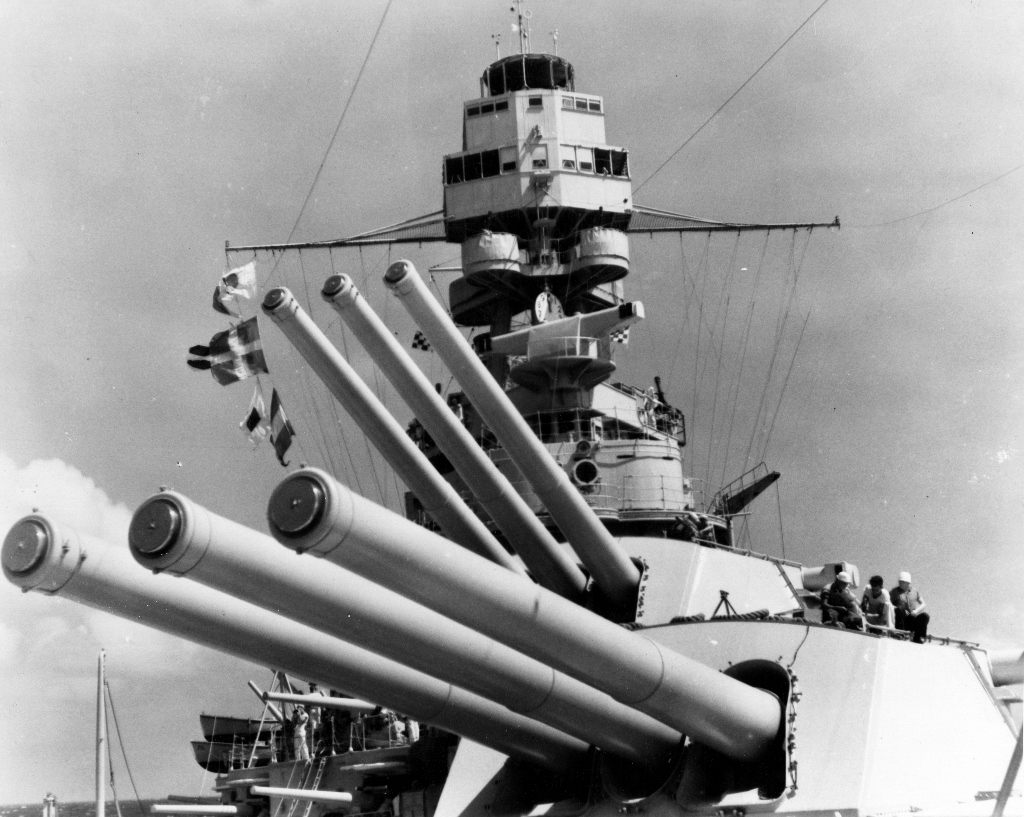
During the modernizations of the the battleships during the 1930s, old 14"/45 (35.6 cm) guns were constructionally upgraded and their chamber volumes enlarged to allow larger charges to give an increased muzzle velocity. Marks 1, 3 and 5 became Marks 8, 9 and 10, respectively. These guns were interchangeable and most battleships had a combination of Mark numbers. Those guns that still had the Fletcher breech mechanism were converted to using the faster-acting Smith-Asbury breech mechanism at this time. An unknown number of guns were given a second key slot in the slide cylinder area which was located 90 degrees away from the first one. Depending upon which slot was given a key, this allowed the guns to be used either in the twin turrets on USS New York (BB-34) and Texas (BB-35) whose breeches opened sideways, or on the battleships of the Nevada (BB-36) and Pennsylvania (BB-38) classes, where their breeches opened downwards. Previously, these guns could only be used in one of the two orientations. See photograph of USS Arizona (BB-39) gun below. The Mark 12 was a further conversion which added chromium plating to the bore to increase barrel life. At least USS Texas (BB-35) and USS Pennsylvania (BB-38) were given these Mark 12 guns when they were regunned in 1944 and these are still on-board USS Texas as of this time (June 2023).
The turrets on the battleships of the Nevada and Pennsylvania classes were further upgraded during the 1930s to increase their maximum gun elevations to 30 degrees. These ships were also now supplied with a heavier AP projectile and by 1942 with a HC projectile. The enlarged propellant charges allowed the heavier AP shell to be used without significant muzzle velocity losses. USS New York and USS Texas were not given this upgrade and not all of their shell hoists at that time could handle the new, longer AP and HC projectiles at this time. For this reason, a modified version of the new AP projectile with a shorter windshield was produced for these ships. See ammunition notes below.
It is often stated that USS Arizona (BB-39) and USS Oklahoma (BB-37) never fired their guns in anger. However, the 14"/45 (35.6 cm) guns Serial Numbers 17, 18 and 19 that were removed from Arizona's Turret II after Pearl Harbor were installed into Turret I on USS Nevada (BB-36) in the fall of 1944. In addition, two guns salvaged from USS Oklahoma, Serial Numbers 65 and 72, were installed into Nevada's Turret III. These guns were then used for shore bombardments during the 1945 Pacific campaigns, so it may be technically said that Arizona's and Oklahoma's guns were fired in anger after all. As a postscript, both guns from Oklahoma were damaged when Nevada was hit by a kamikaze in March 1945. One of the replacement guns was another one salvaged from Oklahoma, Serial Number 76.
USS Arizona's Turret III containing Serial Numbers 20, 29 and 30 and Turret IV containing Serial Numbers 34, 35 and 40 were removed intact from her wreck and were then used as coastal artillery in Hawaii, but these installations were not completed until nearly the end of the war. Arizona's Turret I and its guns, Serial Numbers 16, 32 and 33, were considered too badly damaged to salvage and so still remain on the sunken battleship.
Two 14"/45 (35.6 cm) Mark 12 guns removed from USS Pennsylvania (BB-38) during her last refit, Serial Numbers 22 and 28, are now on display at The Pennsylvania Military Museum. In addition, Serial Number 41, which was used on USS Arizona (BB-39) pre-war and later by USS Nevada (BB-36) at Normandy, is now on display at Wesley Bolin Memorial Park in Phoenix, Arizona. Finally, USS Texas (BB-35) still retains her last outfit of 14"/45 (35.56 cm) Mark 12 guns, Serial Numbers 2, 3, 4, 5, 8, 9, 10, 12, 14 and 25. By coincidence, all but one of these guns, Serial Number 8, comprised the original battery on USS Texas. The missing original gun, Serial Number 23, was at Dahlgren at the end of the war in damaged condition.
| Designation | 14"/45 (35.6 cm) Marks 8, 9, 10 and 12 |
|---|---|
| Ship Class Used On | New York (BB-34), Nevada (BB-36) and Pennsylvania (BB-38) classes |
| Date Of Design | As Modernized: 1928 |
| Date In Service | As Modernized: 1933 |
| Gun Weight | 62 tons (63 mt) |
| Gun Length oa | 642.5 in (16.318 m) |
| Bore Length | 630 in (16.002 m) |
| Rifling Length | 542.7 in (13.530 m) |
| Grooves | 84 |
| Lands | N/A |
| Twist | Uniform RH 1 in 25 |
| Chamber Volume | 17,943 in3 (294.0 dm3) |
| Rate Of Fire | New York class - about 1.25 - 1.5 rounds / minute 1 Nevada and Pennsylvania classes - about 1.5 - 1.75 rounds / minute 2 |
- ^The ammunition handling on the New York class was very labor intensive, it took much manual handling to get the shells and cartridges into the breech. The ROF given above is based upon estimates provided by Tom Scott of Battleship Texas.
- ^The Nevada class added power ramming and had a smoother ammunition flow to the guns, thus improving their ROF.
| Type | Bag |
|---|---|
| Projectile Types and Weights 1a | New York class
AP Mark 20 Mod 1 - 1,500 lbs. (680.4 kg) 2a HC Mark 19 Mod 1 - 1,275 lbs. (578 kg) 2a Bombardment Mark 9 Mod 4 - 1,410 lbs. (639.6 kg) 3a Target Mark 21 Mod 1 - 1,500 lbs. (680.4 kg) 4a Nevada and Pennsylvania classes 5a
|
| Bursting Charge | New York class
AP Mark 20 - 22.90 lbs. (10.4 kg) Explosive D HC Mark 19 Mod 1 - 104.21 lbs. (47.3 kg) Explosive D Bombardment Mark 9 - 105.0 lbs. (47.6 kg) Explosive D Nevada and Pennsylvania classes
|
| Projectile Length | New York class
Mark 20 AP - 54.38 in (138.1 cm) HC Mark 19 Mod 1 - 54.38 in (138.1 cm) Bombardment Mark 9 - 56.00 in (142.2 cm) Target Mark 21 Mod 1- 54.38 in (138.1 cm) Nevada and Pennsylvania classes
|
| Propellant Charge 8a | Full Charge - 425 lbs. (192.8 kg) SPD
Reduced Charge - 205 lbs. (93.0 kg) SPDN
|
| Muzzle Velocity | Full Charge - New Gun
AP - 2,600 fps (792 mps) HC - 2,735 fps (834 mps) Reduced Charge - New Gun
|
| Working Pressure | 18.0 tons/in2 (2,835 kg/cm2) |
| Approximate Barrel Life 9a | Marks 8, 9 and 10: 175 - 200 Rounds
Mark 12: 250 Rounds |
| Ammunition stowage per gun | 100 rounds |
- ^All HC projectiles listed in this section could be used with Point Detonating (PD) or Mechanical Time (MT) fuzes. When used with PD fuzes, they were considered to be HC rounds. When used with MT fuzes, they were considered to be AAC rounds. MT fuzes were probably set by hand on the loading trays.
- ^2.12.22.3As noted above, the New York class (BB-34) used the shorter AP Mark 20 and HC Mark 19 Mod 1 projectiles as their hoists could not handle the longer-nose projectiles used by the other classes. Other than the length of the windshield, the AP projectiles were identical. Some of the older AP Mark 8 projectiles were also issued during World War II, possibly only to the New York class.
- ^At the time of Operation Torch in 1942, HC rounds for these guns were not available, so Bombardment rounds left over from World War I were issued in their place. Bombardment rounds had thick walls and used only a base fuze. They were also longer than the hoists on USS New York and USS Texas were able to handle. For that reason, the Commander, Battleships Atlantic Fleet, ordered that these two ships be modified so as to be able to use these projectiles. Turrets 2 and 4 on both ships had their hoists modified before the battle in order to carry the Bombardment rounds. In February 1944, at least USS Texas, and probably USS New York as well, had their remaining shell hoists modified so that all five turrets could now handle the longer projectiles used on the newer 14" (35.6 cm) ships. This was probably for standardization purposes. Norman Friedman in "US Naval Weapons" states that the New York class was not modified to handle 1,500 lbs. (680.4 kg) projectiles, but this appears to be incorrect.
- ^Target Mark 21 Mod 1 used blind loaded and plugged (BL&P) AP Mark 20 projectile bodies. These were used only by USS New York (BB-34) and USS Texas (BB-35). OP 1664 does not say if dye loads were provided for these target projectiles.
- ^The longer shells used on the Nevada and Pennsylvania classes could also be used for the New York class once their shell hoists were modified in 1944. See note above.
- ^HC Mark 22 was similar to the HC Mark 19 except that the rotating band was about 1.25 inches (3.2 cm) closer to the base.
- ^Target Mark 17 used blind loaded and plugged (BL&P) AP Mark 16 projectile bodies. The Mark 18 was identical to the Mark 17 but used a dye spotting load.
- ^Propellant was in four bags.
- ^AP rounds fired with reduced chargers were rated at 0.10 ESR. HC rounds fired with full charges were rated at 0.78 ESR. HC rounds fired with reduced charges were rated at 0.07 ESR.
- After 1941 AP rounds had a nominal 1.5 lbs. (0.68 kg) dye bag, but this was allowed to be as large as 3.0 lbs. (1.36 kg) in order to bring underweight projectiles up to standard. The following colors were assigned to these ships:
Nevada - Orange
Pennsylvania - Red
New York and Texas - No dyeNew York and Texas were probably not assigned dye colors because their AP projectiles had shorter windshields.
- Bourrelet diameter was 13.977 inches (35.5 cm).
| Elevation | Range | Angle of Fall | Time of Flight | Striking Velocity | Maximum Ordinate |
|---|---|---|---|---|---|
| 1.77 degrees | 4,000 yards (3,658 m) | 1.92 degrees | 4.88 seconds | 2,315 fps (706 mps) | 97 ft (30 m) |
| 3.84 degrees | 8,000 yards (7,315 m) | 4.47 degrees | 10.38 seconds | 2,063 fps (629 mps) | 431 ft (131 m) |
| 5.00 degrees | 10,000 yards (9,144 m) | 6.05 degrees | 13.40 seconds | 1,951 fps (595 mps) | 717 ft (219 m) |
| 6.25 degrees | 12,000 yards (10,973 m) | 7.83 degrees | 16.58 seconds | 1,848 fps (563 mps) | 1,100 ft (335 m) |
| 9.06 degrees | 16,000 yards (14,630 m) | 12.12 degrees | 23.42 seconds | 1,684 fps (513 mps) | 2,204 ft (735 m) |
| 12.27 degrees | 20,000 yards (18,288 m) | 17.12 degrees | 30.91 seconds | 1,563 fps (476 mps) | 3,851 ft (1,174 m) |
| 14.03 degrees | 22,000 yards (20,117 m) | 19.88 degrees | 34.97 seconds | 1,515 fps (462 mps) | 4,934 ft (1,504 m) |
| 18.12 degrees | 26,000 yards (23,774 m) | 26.35 degrees | 44.00 seconds | 1,442 fps (440 mps) | 7,824 ft (2,385 m) |
| 23.22 degrees | 30,000 yards (27,432 m) | 33.83 degrees | 54.47 seconds | 1,404 fps (428 mps) | 12,005 ft (3,659 m) |
| 29.53 degrees | 34,000 yards (31,090 m) | 41.82 degrees | 66.77 seconds | 1,418 fps (432 mps) | 18,060 ft (5,505 m) |
- ^Values for AP Mark 16 from BuOrd OP 1188 page 42.
- ^For the AP Mark 16: The New York class had a maximum gun elevation of 15 degrees. At that elevation, the range would be about 23,000 yards (21,031 m). The Nevada and Pennsylvania classes had a maximum gun elevation of 30 degrees. At that elevation, the range would be about 34,300 yards (31,364 m).
| Elevation | Range | Angle of Fall | Time of Flight | Striking Velocity | Maximum Ordinate |
|---|---|---|---|---|---|
| 1.77 degrees | 4,000 yards (3,658 m) | 1.70 degrees | 4.63 seconds | 2,451 fps (747 mps) | 86 ft (26 m) |
| 3.63 degrees | 8,000 yards (7,315 m) | 4.00 degrees | 9.84 seconds | 2,177 fps (664 mps) | 389 ft (107 m) |
| 4.68 degrees | 10,000 yards (9,144 m) | 5.43 degrees | 12.70 seconds | 2,046 fps (624 mps) | 648 ft (198 m) |
| 5.83 degrees | 12,000 yards (10,973 m) | 7.13 degrees | 15.75 seconds | 1,922 fps (586 mps) | 997 ft (304 m) |
| 8.47 degrees | 16,000 yards (14,630 m) | 11.35 degrees | 22.52 seconds | 1,700 fps (518 mps) | 2,035 ft (620 m) |
| 11.65 degrees | 20,000 yards (18,288 m) | 16.88 degrees | 30.27 seconds | 1,521 fps (464 mps) | 3,690 ft (1,125 m) |
| 13.47 degrees | 22,000 yards (20,117 m) | 20.12 degrees | 34.54 seconds | 1,396 fps (426 mps) | 4,805 ft (1,465 m) |
| 17.65 degrees | 26,000 yards (23,774 m) | 27.38 degrees | 43.93 seconds | 1,354 fps (413 mps) | 7,785 ft (2,170 m) |
| 22.65 degrees | 30,000 yards (27,432 m) | 35.33 degrees | 54.57 seconds | 1,314 fps (401 mps) | 12,010 ft (3,661 m) |
| 28.71 degrees | 34,000 yards (31,090 m) | 43.40 degrees | 66.78 seconds | 1,329 fps (405 mps) | 17,990 ft (5,483 m) |
| 32.37 degrees | 36,000 yards (32,918 m) | 47.42 degrees | 73.83 seconds | 1,356 fps (413 mps) | 21,970 ft (6,696 m) |
- ^Values for HC Mark 19 from BuOrd OP 1188 page 43.
- ^For the HC Mark 19: The New York class had a maximum gun elevation of 15 degrees. At that elevation, the range would be about 23,500 yards (21,490 m). The Nevada and Pennsylvania classes had a maximum gun elevation of 30 degrees. At that elevation, the range would be about 34,700 yards (31,730 m).
| Range | Side Armor | Deck Armor |
|---|---|---|
| 11,500 yards (10,520 m) | 18" (457 mm) | --- |
| 13,500 yards (12,350 m) | --- | 2" (51 mm) |
| 14,800 yards (13,530 m) | 16" (406 mm) | --- |
| 18,800 yards (17,190 m) | 14" (356 mm) | --- |
| 23,400 yards (21,400 m) | 12" (305 mm) | --- |
| 24,500 yards (22,400 m) | --- | 4" (102 mm) |
| 28,300 yards (25,880 m) | 10" (254 mm) | --- |
| 31,500 yards (28,800 m) | --- | 6" (152 mm) |
| 34,300 yards (31,360 m) | 8" (203 mm) | --- |
| 36,300 yards (33,190 m) | --- | 8" (203 mm) |
- These figures are taken from USN armor penetration curves published in 1942 as shown in "US Naval Weapons".
- The AP Mark 20 probably had slightly less penetration, as its shorter, less aerodynamic ballistic cap would have resulted in somewhat lower striking velocities.
| Designation | Two-gun Turrets
New York (5) and Nevada (2) Triple Turrets
|
|---|---|
| Weight | Two-gun Turret
New York Class: 532 tons (541 mt) Nevada Class: 618 tons (628 mt) Triple Turret
|
| Elevation 1e | New York class: -5 / +15 degrees
Others: -5 / +30 degrees |
| Rate of Elevation | about 4 degrees per second |
| Train | about -150 / +150 degrees |
| Rate of Train | about 2 degrees per second |
| Gun Recoil | 40 in (102 cm) |
| Loading Angle | 0 degrees |
- ^A Note on Sources: Some references erroneously claim that the mountings on the New York class were reworked in November 1941 to increase their maximum elevation to +30 degrees. However, my personal inspection in 1984 of the guns and mountings on USS Texas (BB-35) quickly showed that she was not modified and that her guns cannot elevate past the original +15 degree maximum elevation.
- See 14"/45 (35.6 cm) Mark 1 data page for other information on these mountings.
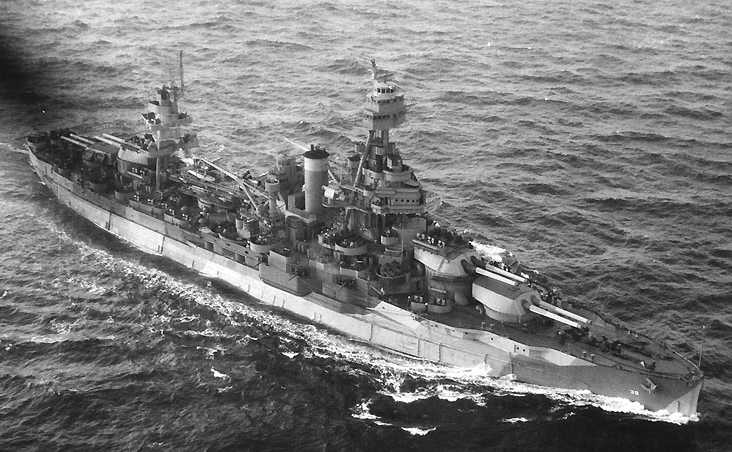
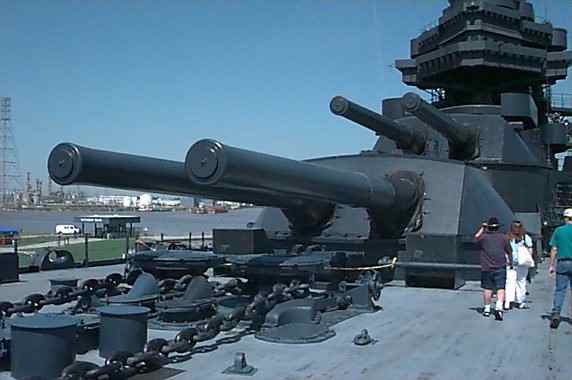
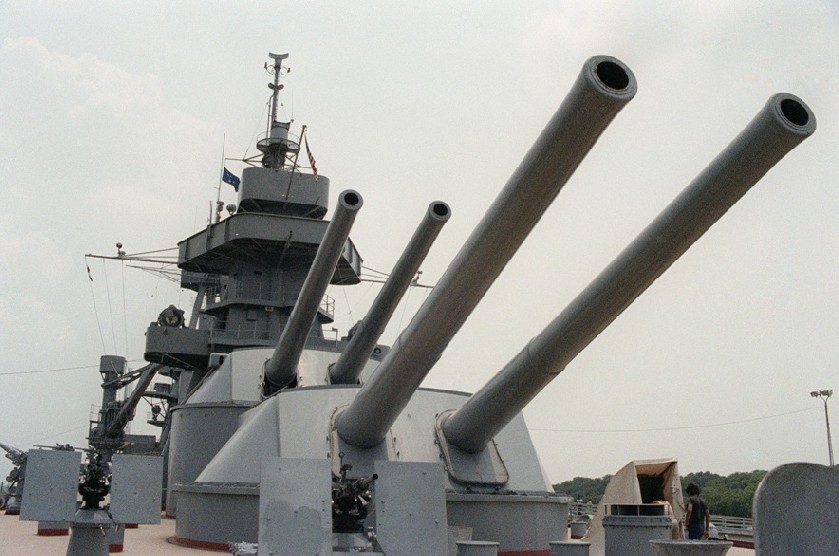
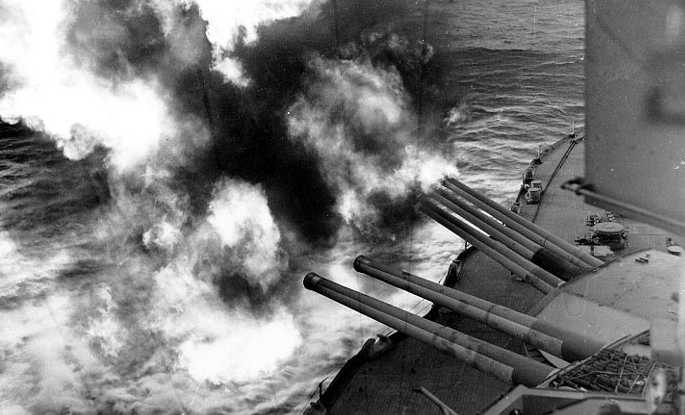
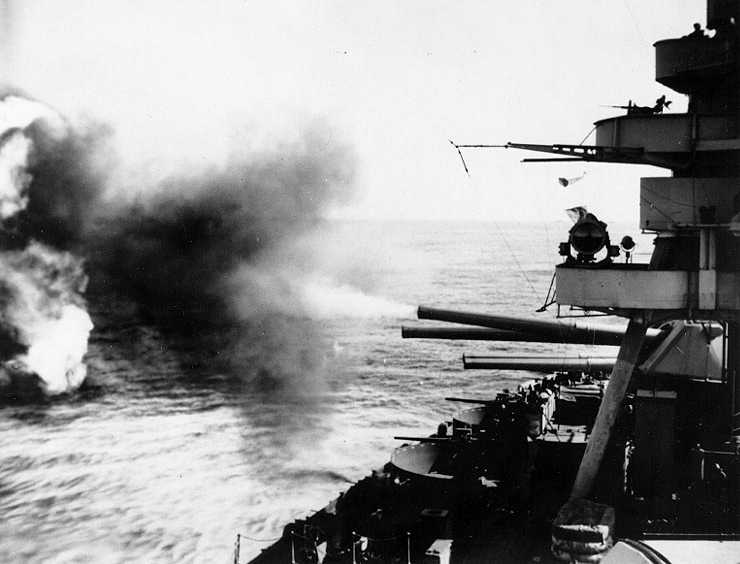
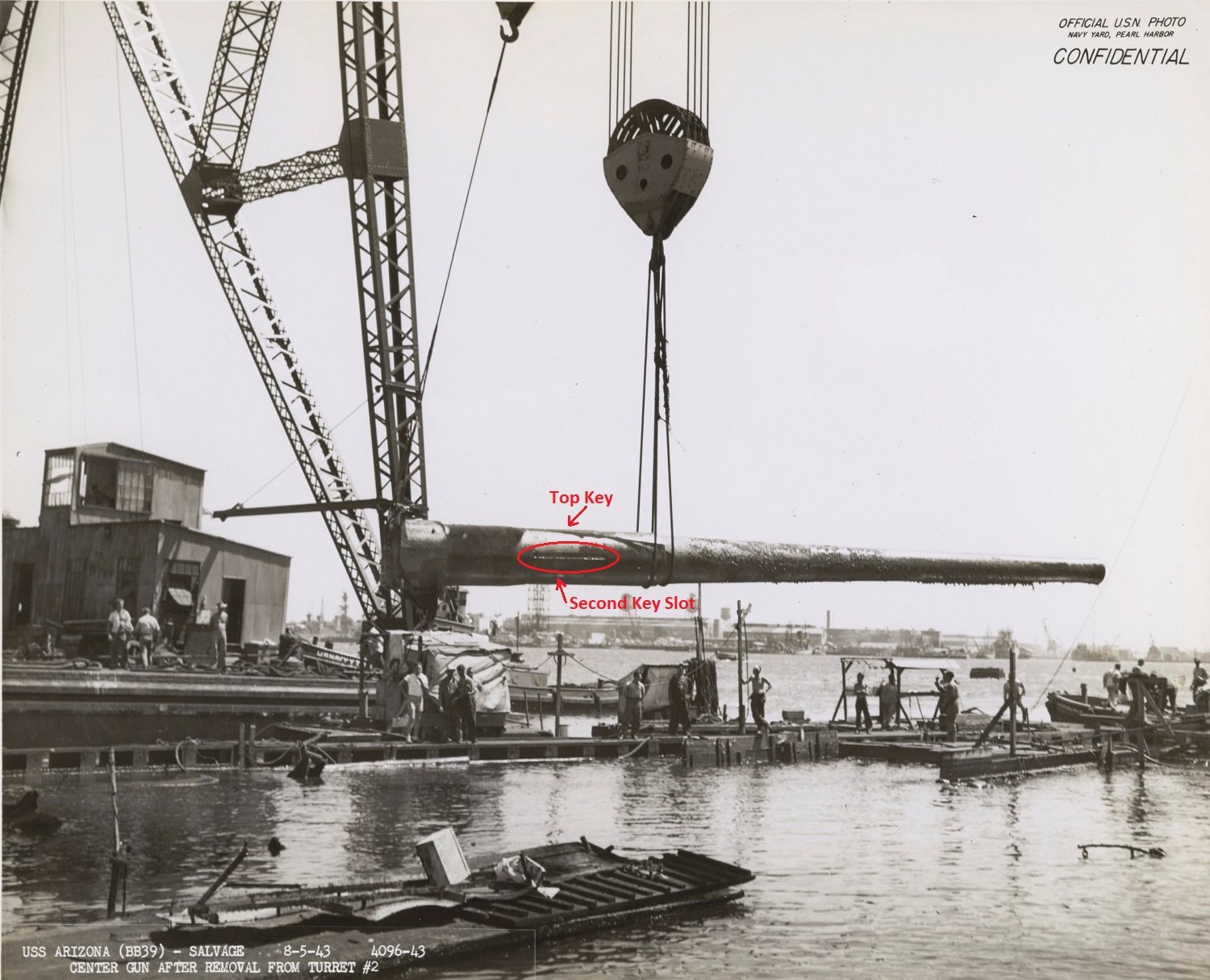
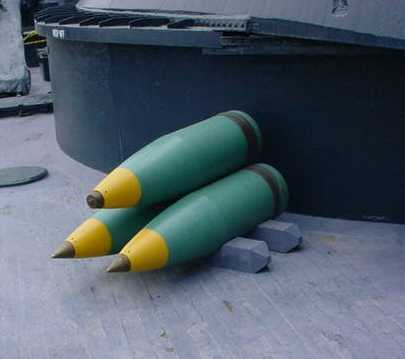
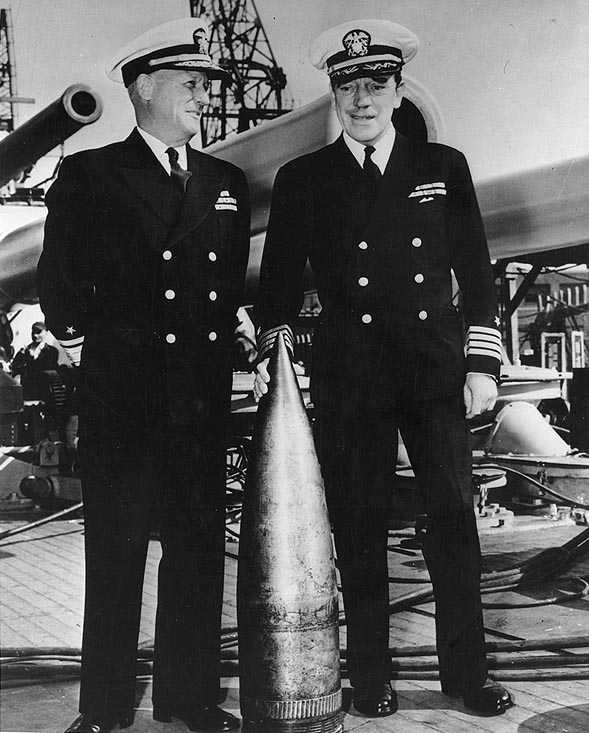
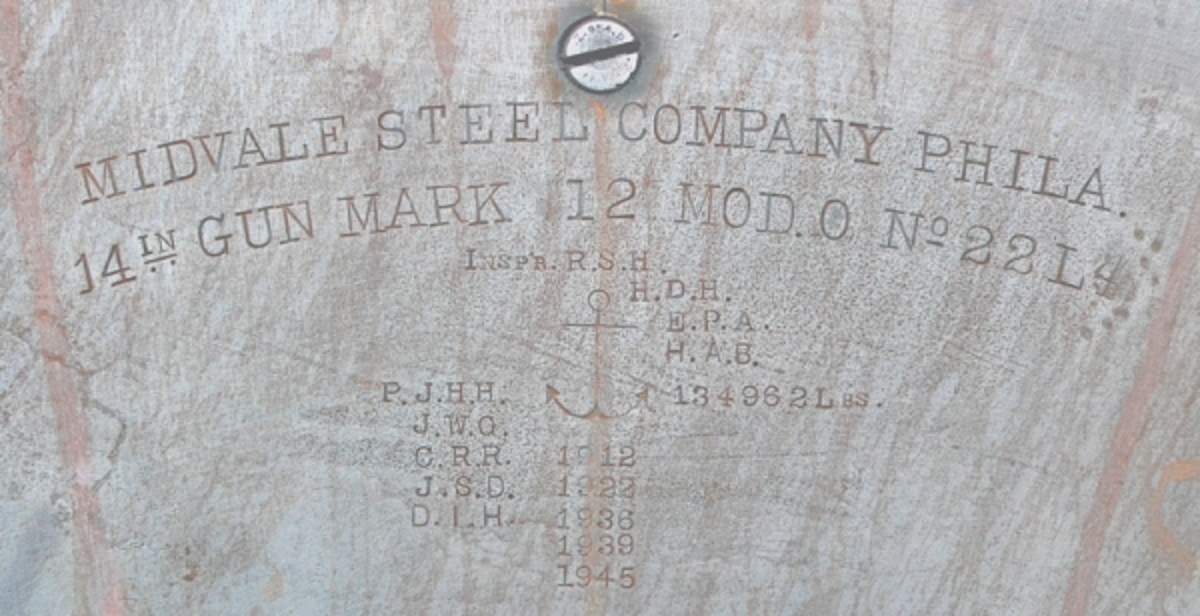
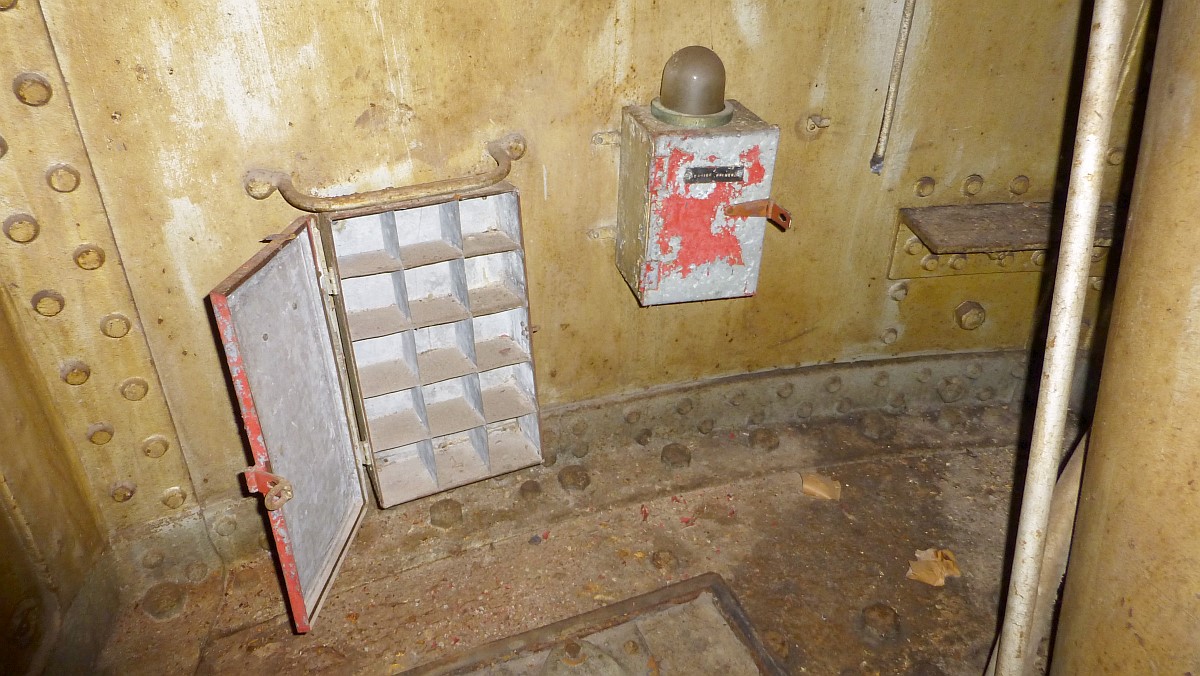
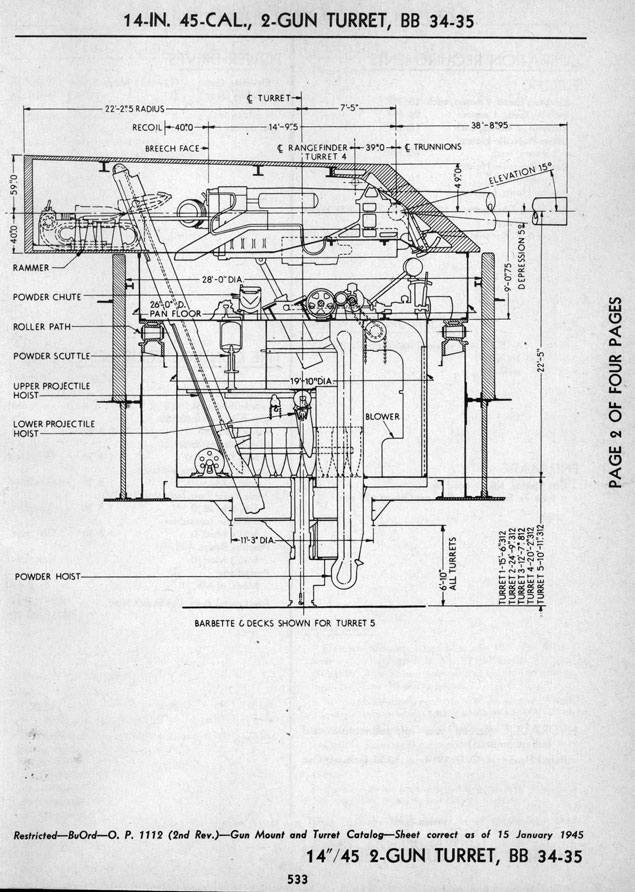
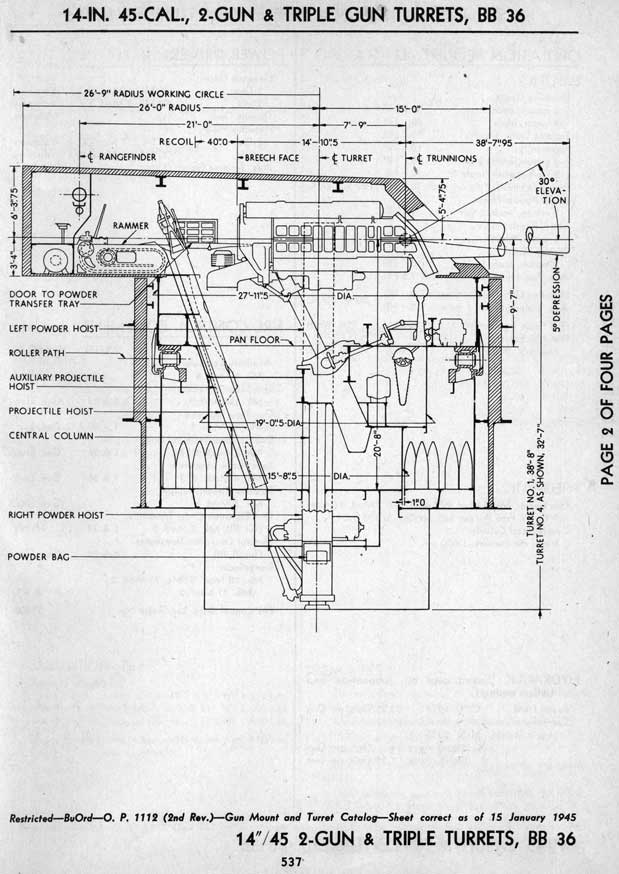
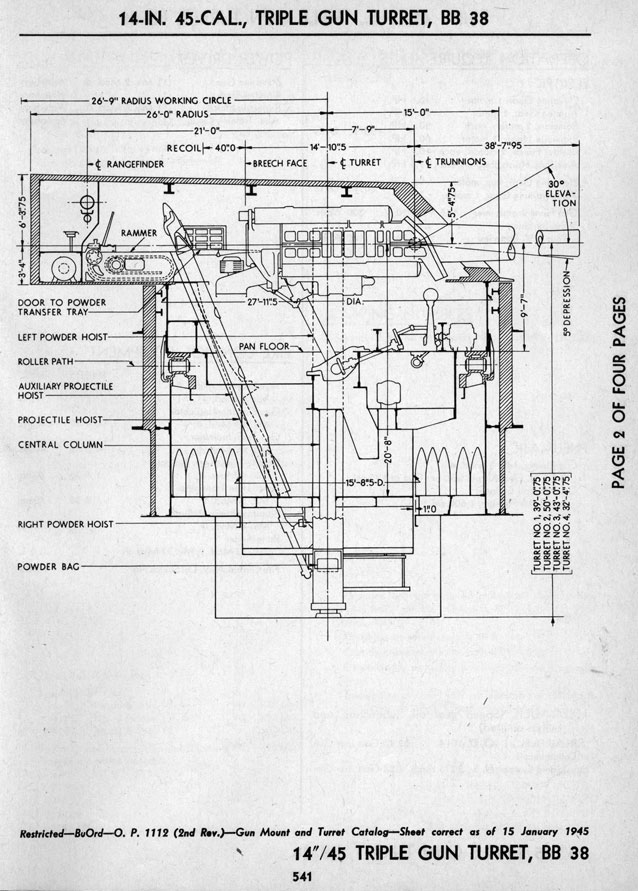
Tom Scott video of Battleship Texas:
- Describing the barrel life and history of 14"/45 (35.6 cm) guns
"Naval Weapons of World War Two" by John Campbell
"US Naval Weapons," "US Battleships: An Illustrated Design History" and "Battleship Design and Development 1905-1945" all by Norman Friedman
"Battleships: United States Battleships, 1935-1992" by W.H. Garzke, Jr. and R.O. Dulin, Jr.
---
"Main Battery Guns of Battleship Texas (BB-35)" an unpublished monograph dated 26 August 2002 by Christopher C. Wright, Editor, Warship International
---
"USS Massachusetts 1945 Gunnery Doctrine" by Bureau of Ordnance (BuOrd), Department of the Navy
"Breech Mechanism - General Description of All 14-inch Breech Mechanisms in Service - Ordnance Pamphlet No. 283 - April 1930" by Bureau of Ordnance (BuOrd), Department of the Navy
"Abridged Range Tables for U.S. Naval Guns - Ordnance Pamphlet No. 1188 - 13 June 1944" by Bureau of Ordnance (BuOrd), Department of the Navy
"U.S. Explosive Ordnance - Ordnance Pamphlet No. 1664 - May 1947" by Bureau of Ordnance (BuOrd), Department of the Navy
---
Gene Slover's Navy Pages
---
Letter of 19 February 1944 by E.E. Mann to the Commandant of the Boston Navy Yard regarding turret hoists alterations
---
Arizona's World War II Memorial: Guns to Salute the Fallen
---
Tony DiGiulian's personal data files
---
Special help by Keith Allen, Ed Jackson, Peter DeForest, Tom Scott, Travis Davis and William Jurens
20 October 2008 - Benchmark
08 July 2010 - Corrected picture caption for USS Texas (BB-35)
02 February 2014 - Added link to The Pennsylvania Military Museum
12 June 2014 - Corrected typographical error
09 May 2015 - Redid photograph of USS Pennsylvania (BB-38)
14 July 2016 - Converted to HTML 5 format
15 August 2018 - Redirected link to The Pennsylvania Military Museum, reorganized notes
22 December 2018 - Added turret sketches
29 March 2021 - Added photograph of fuze and primer cabinets and photograph of breech
25 March 2022 - Updated ROF, minor formatting changes, added comment about 24 cm shell hit on USS Texas (BB-35)
04 June 2022 - Added Target projectiles, note on 1944 turret hoists alterations on New York (BB-34) class
26 May 2023 - Added link to barrel life and history video
25 June 2023 - Added comments about Fletcher and Smith-Asbury breech mechanisms, second key slot comment and photograph of USS Arizona (BB-39) gun being salvaged
30 August 2023 - Revised notes regarding shell hoists on the New York class (BB-34), revised range tables and added serial numbers for guns removed
from USS Arizona (BB-39) and USS Oklahoma (BB-37), added note about barrel life
